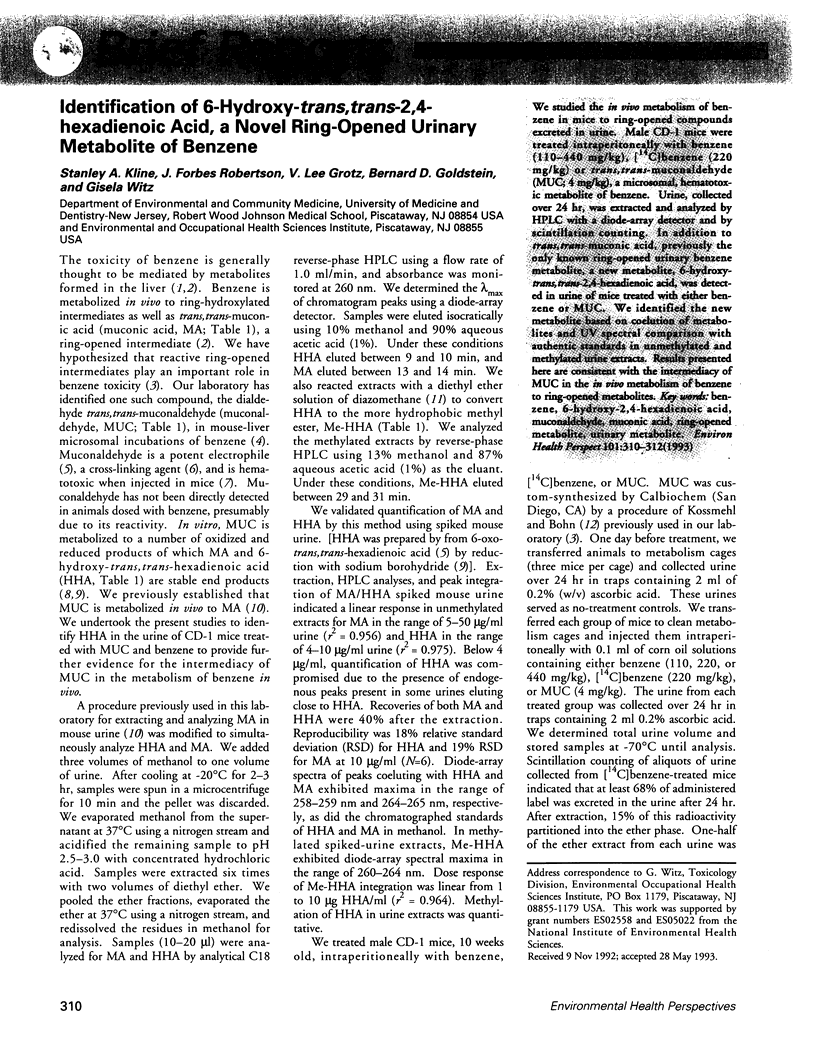Abstract
We studied the in vivo metabolism of benzene in mice to ring-opened compounds excreted in urine. Male CD-1 mice were treated intraperitoneally with benzene (110-440 mg/kg), [14C]benzene (220 mg/kg) or trans, trans-muconaldehyde (MUC; 4 mg/kg), a microsomal, hematotoxic metabolite of benzene. Urine, collected over 24 hr, was extracted and analyzed by HPLC with a diode-array detector and by scintillation counting. In addition to trans,trans-muconic acid, previously the only known ring-opened urinary benzene metabolite, a new metabolite, 6-hydroxy-trans,trans-2,4-hexadienoic acid, was detected in urine of mice treated with either benzene or MUC. We identified the new metabolite based on coelution of metabolites and UV spectral comparison with authentic standards in unmethylated and methylated urine extracts. Results presented here are consistent with the intermediacy of MUC in the in vivo metabolism of benzene to ring-opened metabolites.
Full text
PDF


Images in this article
Selected References
These references are in PubMed. This may not be the complete list of references from this article.
- Goon D., Cheng X., Ruth J. A., Petersen D. R., Ross D. Metabolism of trans,trans-muconaldehyde by aldehyde and alcohol dehydrogenases: identification of a novel metabolite. Toxicol Appl Pharmacol. 1992 May;114(1):147–155. doi: 10.1016/0041-008x(92)90107-4. [DOI] [PubMed] [Google Scholar]
- Johnson E. S., Lucier G. Perspectives on risk assessment impact of recent reports on benzene. Am J Ind Med. 1992;21(5):749–757. doi: 10.1002/ajim.4700210513. [DOI] [PubMed] [Google Scholar]
- Latriano L., Goldstein B. D., Witz G. Formation of muconaldehyde, an open-ring metabolite of benzene, in mouse liver microsomes: an additional pathway for toxic metabolites. Proc Natl Acad Sci U S A. 1986 Nov;83(21):8356–8360. doi: 10.1073/pnas.83.21.8356. [DOI] [PMC free article] [PubMed] [Google Scholar]
- PARKE D. V., WILLIAMS R. T. Studies in detoxication. XLIX. The metabolism of benzene containing (14C1) benzene. Biochem J. 1953 May;54(2):231–238. doi: 10.1042/bj0540231. [DOI] [PMC free article] [PubMed] [Google Scholar]
- Sammett D., Lee E. W., Kocsis J. J., Snyder R. Partial hepatectomy reduces both metabolism and toxicity of benzene. J Toxicol Environ Health. 1979 Sep;5(5):785–792. doi: 10.1080/15287397909529789. [DOI] [PubMed] [Google Scholar]
- Witz G., Maniara W., Mylavarapu V., Goldstein B. D. Comparative metabolism of benzene and trans,trans-muconaldehyde to trans,trans-muconic acid in DBA/2N and C57BL/6 mice. Biochem Pharmacol. 1990 Sep 15;40(6):1275–1280. doi: 10.1016/0006-2952(90)90393-y. [DOI] [PubMed] [Google Scholar]
- Witz G., Rao G. S., Goldstein B. D. Short-term toxicity of trans,trans-muconaldehyde. Toxicol Appl Pharmacol. 1985 Sep 30;80(3):511–516. doi: 10.1016/0041-008x(85)90396-5. [DOI] [PubMed] [Google Scholar]



